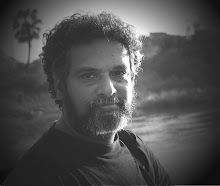Gubbi Veeranna Reincarnated…
It was all Karnataka in Desh parv yesterday, 09th of October. At Sriram centre the legendary play Sadarame by Gubbi Veeranna and his company theatre in the 1940’s was reproduced by Spandana Bangalore directed by none other than B Jayashree, the granddaughter of Gubbi Veeranna. She directed the play as well acted the role of Kalla (Thief) that Gubbi Veeranna himself acted. The play was produced true to the traditional style of the company Sangeetha Natakam of those bygone years, with actors singing, painted Curtains, costumes, and comedy, but abridged. Thus it gave an opportunity for the theatre enthusiasts to have a feel of those bygone days and its theatre sensibilities. Of course there was restraint in the glittering of the costumes, the set becoming more three dimensional and lighting that patched the modern knowledge of theatre, and actors somehow feeling uneasy to sing and act out extravagantly. The greatest thing about the whole evening was of course see Jayashree act out the role of a male thief very passionately and with ease as a tribute to her grandfather…It seems emotional and personal gratifying for her in the whole act itself and a delight for the audience to watch.
The story line of the play written by B.N Shastry based on a folk tale is simple. Prince Jayaveera is not interested in the worldly life or in ascending his father’s throne, and is quite content to be pursuing philosophy. However, this changes when he meets Sadarame, a beautiful, innocent middle-class girl, and succeeds in marrying her. And that is when all their troubles begin. Even as hardships challenge young Sadarame, she overcomes every hurdle with her intelligence, and the play ends on a happy note.
And the day was almost excelled by Karnnataka artists. A Yakshagana performance KARTHAVEERYARJUNA KALAGA was performed by Sri Idagunji Mahaganapati Yakshagana Mandali, Keremane under the direction and choreography by Keremane Shivananda Hegde.
Yakshagana is a generic term referring mainly to a traditional form of Kannada theatre predominant in coastal Karnataka, variants of which are found in other parts of the state as well, under names such as Bayalata, Dasavatar, and Bhagavatara Ata. The distinct identity of the form is the Bhakti movement that provided an ideological framework and structured and the second is Bhutaradhane – ritual forms of the Dakshina Kannad region from which Yakshagana borrowed elements of dance, costume, make-up, and movement pattern. Yakshagana absorbed these variegated influences; it began to evolve its unique style, growing into a lively medieval entertainment.
Yakshagana can take place virtually in any open space and is financed by patrons or the village community. Usually a troupe consists of one or two singers (Bhagavatas), at least three instrumentalists – a maddale drummer, one for chende, and one to provide the drone on a harmonium – and ten to fifteen actors playing both male and female roles.
Yakshagana has developed an elaborate system of metrical compositions, postures, and choreographic patterns. It lays emphasis on the entire body rather than just the hands and face. Likewise, the speech ranges from the musical-rhetorical to normal conversational, the make-up from mask-like ornamentation to the bare minimum, and the costumes from large headdresses and decorations to ordinary dhotis and turbans.
The battle between the demon King Ravana and Karthaveerarjuna was performed with all the characteristics of this powerful and spectacular theatre form with ease and élan.
The morning session of the ongoing cultural extravaganza of Sangeet Natak Akademi echoed with soothing musical performances. The performances included Odissi Sangeet presented by Ramhari Das & group and Haveli Sangeet presented by Chandra Prakash.
Odissi music, primarily practiced in the state of Orissa, belongs to the Udramagadhi branch of ancient Indian music. In its present form, Odissi music gives great importance to the lyric, where words are required to be sung without fragmentation or distortion. The Odissi style of music has some similarity with the Hindustani Dhrupad style. The percussion instrument used, the Mardal, is also similar to the Pakhawaj. Odissi is thus a very old classical style of music with specific ragas, talas, and its own special style of rendering of lyrics and melody.
Haveli Sangeet or the Music of the Lord's House is Vaishnavite temple music which originated in Braj in the early sixteenth century as an integral part of worship in the temple of Sri Nathiji or Lord of Govardhan (Krishna). Haveli Sangeet actually refers to the music performed in the Haveli temples (‘house’ or ‘mansion’ in Persian) that predominates in Rajasthan.
Observed SNA’s Secretary, Jayant Kastuar “Odissi Sangeet by Guru RamHari Das & group gave us a glimpse of its rich sahitya and its linkages with the Jagarnath Temple of Puri”.
The afternoon session of Desh Parv consisted of folk dances form various states of India making the spectators dance to its beat.
“Desh Parv”, the 10-day festival of performing arts of India promises to offer the citizens and the international tourist’s unique bouquet of Indian music, dance, theatre, folk, and narrative arts.
![Sadarame_--_PhotographybyAkshayNarayan_small[1] Sadarame_--_PhotographybyAkshayNarayan_small[1]](https://blogger.googleusercontent.com/img/b/R29vZ2xl/AVvXsEgFwcdpgcv2gi1lJFt2LxERUTrjHPDILCtPrvea25oByvfPMLIDLVBhj1ubXtw3qtld32rs1drSo1vFBqnWAqivRABFfFJwleC-lGfuJAGR3krG36U0yiyeljce8X0fDj1Ij4B-KiIEmLXo/?imgmax=800)



0 Comments:
Post a Comment
Subscribe to Post Comments [Atom]
<< Home